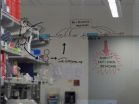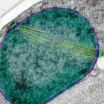(Press-News.org) Tamoxifen, a drug currently used to treat breast cancer, also kills a fungus that causes a deadly brain infection in immunocompromised patients. The findings, which could lead to new treatments for a disease that kills more HIV/AIDS patients than tuberculosis, appear in mBio®, the online open-access journal of the American Society for Microbiology (ASM.)
"This work sets the stage for additional animal studies to see if tamoxifen can be used as a drug in people and will allow us to design new drugs related to tamoxifen that are better antifungals," says Damian Krysan of the University of Rochester, an author on the study.
Cryptococcosis is one of the most prevalent human fungal infections, responsible for approximately 1 million new infections and 620,000 deaths worldwide each year. The disease strikes primarily people living with HIV/AIDS and causes more deaths in this population than tuberculosis. It manifests as either pneumonia or a brain infection known as meningoencephalitis.
"The gold standard therapy for this infection is a combination of amphotericin B and 5-flucytosine. These drugs were first used in the late 1950s when penicillin was the antibiotic of choice. There have been no substantial improvements in the treatment of this disease in a half-century and the therapy is not available in many regions of the world that need it most," says Krysan.
In areas of the world where the gold-standard therapy is not available, like sub-Saharan Africa, the drug of choice is fluconazole because it is widely available and inexpensive. Unfortunately, it is much less effective since it does not actually kill the fungus.
"Recently, interest in re-using old drugs to treat new diseases has increased as a way to develop new therapies more quickly. We screened a large collection of old drugs for drugs that kill Cryptococcus and rediscovered tamoxifen," says Krysan. "We used clinical microbiology tests to determine whether the molecules had promising activity against Cryptococcus both alone and in combination with other antifungal drugs such as fluconazole. The combination of tamoxifen and fluconazole was synergistic; this means that the combination is more than 4-times more active than either alone."
Krysan and his colleagues also demonstrated that tamoxifen does not kill the fungus in the same way it works against breast cancer. Instead, it inhibits proteins related to calmodulin, an important calcium binding protein. They found that by making modifications to tamoxifen that improve its ability to interfere with calmodulin, they also improved its ability to kill Cryptococcus.
"An effective, widely available treatment for cryptococcal meningitis is an unmet clinical need of global importance," says Krysan. "These results indicate that tamoxifen is a pharmacologically attractive scaffold for the development of new anti-cryptococcal drugs and provide a mechanistic base for its further optimization."
INFORMATION:
mBio® is an open access online journal published by the American Society for Microbiology to make microbiology research broadly accessible. The focus of the journal is on rapid publication of cutting-edge research spanning the entire spectrum of microbiology and related fields. It can be found online at http://mbio.asm.org.
The American Society for Microbiology is the largest single life science society, composed of over 39,000 scientists and health professionals. ASM's mission is to advance the microbiological sciences as a vehicle for understanding life processes and to apply and communicate this knowledge for the improvement of health and environmental and economic well-being worldwide.
Breast cancer drug fights fungal disease
2014-02-11
ELSE PRESS RELEASES FROM THIS DATE:
Study shows drop in crime rates is less where Wal-Mart builds
2014-02-10
Communities across the United States experienced an unprecedented decline in crime in the 1990s. But for counties where Wal-Mart built stores, the decline wasn't nearly as dramatic.
"The crime decline was stunted in counties where Wal-Mart expanded in the 1990s," says Scott Wolfe, assistant professor of criminology and criminal justice at the University of South Carolina and lead author of a new study. "If the corporation built a new store, there were 17 additional property crimes and 2 additional violent crimes for every 10,000 persons in a county."
The study, titled ...
Newly found tactics in offense-defense struggle with hepatitis C virus
2014-02-10
The hepatitis C virus (HCV) has a previously unrecognized tactic to outwit antiviral responses and sustain a long-term infection. It also turns out that some people are genetically equipped with a strong countermeasure to the virus' attempt to weaken the attack on it.
The details of these findings suggest potential targets for treating HCV, according to a research team led by Dr. Ram Savan, assistant professor of immunology at the University of Washington. The study was published in Nature Immunology.
HCV infects more than 150 million of the world's people. The ...
NTU showcases expertise in UAV technology at Singapore Airshow 2014
2014-02-10
Nanyang Technological University (NTU) will be showcasing its latest R&D expertise in Unmanned Aerial Vehicle (UAV) technology at the Singapore Airshow, one of the most important aerospace and defence exhibitions in the world, held from 11 to 16 February.
Visitors to the Singapore Airshow will be able to see 12 drones, programmed by NTU scientists and researchers, flying in formation within inches of each other and executing complex indoor aerial manoeuvres.
In addition to the formation air-show by 12 quad-rotor Unmanned Aerial Vehicles complete with strobe lights ...
Australians discover oldest star
2014-02-10
A team led by astronomers at The Australian National University has discovered the oldest known star in the Universe, which formed shortly after the Big Bang 13.7 billion years ago.
The discovery has allowed astronomers for the first time to study the chemistry of the first stars, giving scientists a clearer idea of what the Universe was like in its infancy.
"This is the first time that we've been able to unambiguously say that we've found the chemical fingerprint of a first star," said lead researcher, Dr Stefan Keller of the ANU Research School of Astronomy and Astrophysics.
"This ...
New maps reveal locations of species at risk as climate changes
2014-02-10
An international team of scientists has produced global maps showing how fast and in which direction local climates have shifted.
In research published today in the journal Nature, CSIRO and an international team of scientists revealed global maps showing how fast and in which direction local climates are shifting. This new study points to a simpler way of looking at climatic changes and their likely effects on biodiversity.
As climate change unfolds over the next century, plants and animals will need to adapt or shift locations to track their ideal climate.
"The ...
JCI early table of contents for Feb. 10, 2014
2014-02-10
Researchers identify unique regulatory T cell population in human skin
Regulatory T cells (Tregs) dampen the immune response against self antigens and contribute to the prevention of autoimmunity. A skin-specific population of Tregs (mTreg) has been described in mice that has properties similar to memory T cells. In mice, some mTregs are maintained in the skin for long periods of time and suppress cutaneous autoimmunity. In this issue of the Journal of Clinical Investigation, Michael Rosenblum and colleagues at the University of California San Francisco analyzed the mTreg ...
Obesity, type 2 diabetes epidemics spreading to developing world as more own TVs, computer
2014-02-10
Lower income countries may soon be facing the same obesity and diabetes epidemics as their higher income counterparts. Ownership of televisions, cars and computers was recently found to be associated with increased rates of obesity and diabetes in lower and middle income countries, according to an international study published in CMAJ (Canadian Medical Association Journal).
"Although we found no trend between household devices ownership and obesity or diabetes in high income countries, there was a stronger relation as the level of country income decreased. This relation ...
Supreme Court of Canada ruling on life support has wider impact: Hassan Rasouli
2014-02-10
In the debate over whether to withdraw life support for patients who have no hope of recovery, the recent judgment by the Supreme Court of Canada on the Hassan Rasouli case in Ontario has broader implications for health care in the country, argue authors in a commentary in CMAJ (Canadian Medical Association Journal).
The Supreme Court of Canada ruled in October 2013 that physicians who recommend withdrawing life support over the wishes of substitute decision-makers must apply to Ontario's Consent and Capacity Board, "regardless of whether they feel ongoing treatment falls ...
Researchers call for more study into impact of repetitive heading in soccer
2014-02-10
TORONTO, Feb. 10, 2014—Soccer is the most-popular and fastest-growing sport in the world and, like many contact sports, players are at risk of suffering concussions from collisions on the field.
But researchers warned in a paper published today that not enough attention has been given to the unique aspect of soccer – the purposeful use of the head to control the ball – and the long-term consequences of repetitive heading.
The literature review by Dr. Tom Schweizer, director of the Neuroscience Research Program of St. Michael's Hospital, was published in the journal ...
Conserved nuclear envelope protein uses a shuttle service to travel between job sites
2014-02-10
KANSAS CITY, MO—Researchers at the Stowers Institute for Medical Research have glimpsed two proteins working together inside living cells to facilitate communication between the cell's nucleus and its exterior compartment, the cytoplasm. The research provides new clues into how a crucial protein that is found in organisms from yeast to humans does its work.
The study, led by Stowers Investigator Sue Jaspersen, Ph.D., focused on a protein called Ndc1, which controls when and where a cell inserts holes into the double-walled membrane that surrounds its nucleus. In yeast, ...




